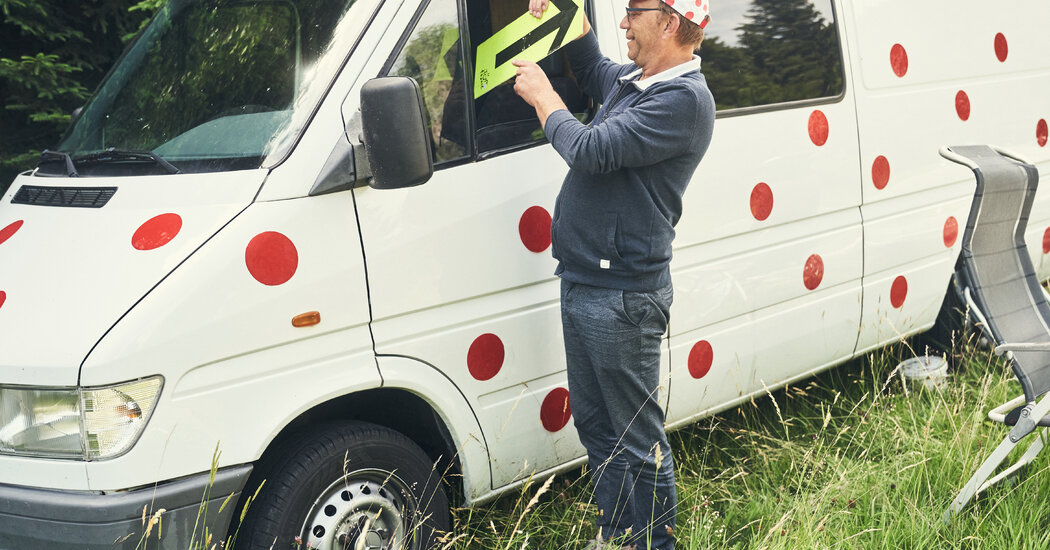
The cyclists competing in this year’s Tour de France will spend nearly a month on their bikes, earning only two days off during their sport’s most famous marathon. When the race ends on Sunday in Paris, the survivors and their teams will be able to look back on more than 2,000 miles spent navigating not only tens of thousands of twists and turns, but also punishing climbs and harrowing descents, tight curves and grinding switchbacks, narrow lanes and lonely breakaways.
Yet with that much distance covered and that many opportunities to make a mistake, one question is not asked enough:
How do the cyclists always seem to know where they’re going?
There is a team for that, too: Luc Kerlouet and his group of self-described “arrowers.” They do not see much of the race itself; instead, they are responsible for leading each stage of the Tour de France by 24 to 48 hours and laying down the bright yellow signs that play the vital role of directing the cyclists through a month’s worth of racing.
Colloquially referred to in France as “les flèches” — the arrows — the 20,000 boldly colored directional signs used in the race are posted on street signs, light poles and other permanent fixtures in number-coded patterns that let the cyclists know what to expect on the course ahead. Their placement is not random: The more arrows laid down, the tighter the turns ahead. Ambiguity is the enemy.
“Each morning at 8 a.m., the team leaves to set up our signs,” Kerlouet said. “On flatter stages, we install about 1,200 arrows. On mountain days with more elevation, we usually install about 400. Our team is so synchronized in doing this that from the time our van stops to the time the arrow is posted and our crew member is back in the car, only 10 seconds has passed.”
The simple signs are a bit of nostalgia, a sentimental nod to the reliance on them in earlier days of the century-old race, long before two-way radios and handlebar-mounted bike computers offered riders precise information in real time. Yet the arrows still retain their value, according to Ian Boswell, an American who competed in the Tour de France in 2018.
“There are technologies these days that let you ride the stages digitally and see what they’re like,” Boswell said, “but it’s not the same as riding them in person.”
However, it isn’t always possible for each cyclist to personally scan every mile of road across the country, especially when surrounded in the center of a tightly packed peloton. To compensate, team directors will preview the course, driving the entire route with video cameras that allow them, in the hours before each day’s stage, to pinpoint areas of concern, or opportunity.
“That’s why the signs still play such an important role,” Boswell said. “As a rider, you’re overloaded with information. You get so much information on the stage an hour before racing, and the signs can be a helpful safety net.”
Aside from their purely utilitarian value, though, les flèches have also taken on their own identity as collectibles in the world of cycling fandom.
“The arrows, they’re iconic,” said Rob Huxtable, an English fan who has attended 15 editions of the Tour. “A lot of the old ones were just the arrow without any markings on them, and now they come with the logos in the corners for the Tour de France. They’re memorabilia for the fact that you’ve been there and seen the Tour.”
While the Tour doesn’t explicitly prohibit fans from taking the signs as souvenirs, there is a code of conduct detailing when and where the signs can be removed. If signs are snatched before the last cyclist of a stage has passed, their absence can cause confusion on the road and create safety issues for the race.
“In 2019, during the time trials where we stayed, there was a tight turn and there were four arrows posted there,” said Ib Hansen, a devoted fan who has followed the race for more than 20 years. “I said to my wife: ‘Don’t take one before the day is over. If there are four signs, it means there’s a sharp turn.’”
Later in the day, one of the signs went missing.
“When one of the first riders came by — Boom! He crashed,” Hansen said. “And then my wife believed me.”
Kerlouet said his team of arrowers estimated that it recovered only about 5 percent of les flèches that they put out, and at the Tour there are regular sightings of RV windows plastered with arrows. Huxtable said he had only a couple in his collection, and Hansen initially demurred when asked if he planned to grab a few more this summer.
“I think we have enough for now,” he said. But after a quick glance at his wife, he seemed to change his tune. “Fine,” he said. “Maybe one more.”